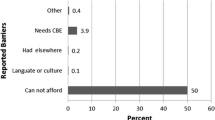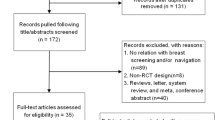Abstract
Objectives
Patient navigation (PN) services have been shown to improve cancer screening in disparate populations. This study estimates the cost-effectiveness of implementing PN services within the National Breast and Cervical Cancer Early Detection Program (NBCCEDP).
Methods
We adapted a breast cancer simulation model to estimate a population cohort of women aged 40–64 years from the NBCCEDP through their lifetime. We incorporated their screening frequency and screening and diagnostic costs.
Results
Within the NBCCEDP, Program with PN (vs. No PN) resulted in a greater number of mammograms per woman (4.23 vs. 4.14), lower lifetime mortality from breast cancer (3.53% vs. 3.61%), and fewer missed diagnostic resolution per woman (0.017 vs. 0.025). The estimated incremental cost-effectiveness ratios for a Program with PN was $32,531 per quality-adjusted life-years relative to Program with No PN.
Conclusions
Incorporating PN services within the NBCCEDP may be a cost-effective way of improving adherence to screening and diagnostic resolution for women who have abnormal results from screening mammography. Our study highlights the value of supportive services such as PN in improving the quality of care offered within the NBCCEDP.
Similar content being viewed by others
References
U.S. Cancer Statistics Working Group (2017) United States Cancer Statistics: 1999–2014 Incidence and Mortality Web-based Report. Atlanta: U.S. Department of Health and Human Services, Centers for Disease Control and Prevention and National Cancer Institute. www.cdc.gov/uscs
Siu AL, USPSTF (2016) Screening for breast cancer: U.S. Preventive Services Task Force Recommendation Statement. Ann Intern Med 164(4):279–296
Oeffinger KC, Fontham ET, Etzioni R et al (2015) Breast cancer screening for women at average risk: 2015 guideline update from the American Cancer Society. JAMA 314(15):1599–1614
White A, Thompson TD, White MC, Sabatino SA, de Moor J, Doria-Rose PV, Geiger AM, Richardson LC (2017) Cancer screening test use—United States, 2015. MMWR Morb Mortal Wkly Rep 66(8):201–206. https://doi.org/10.15585/mmwr.mm6608a1
CDC Division of Cancer Prevention and Control. National Breast and Cervical Cancer Early Detection Program (NBCCEDP), About the Program, Accomplishments [Internet]. CDC Cancer Division. www.cdc.gov/cancer/nbccedp/about.htm
Bhanegaonkar A, Madhavan SS, Khanna R, Remick SC (2012) Declining mammography screening in a state Medicaid Fee-for-Service program: 1999–2008. J Womens Health (Larchmt). 21(8):821–829
Peipins LA, Graham S, Young R, Lewis B, Foster S, Flanagan B, Dent A (2011) Time and distance barriers to mammography facilities in the Atlanta metropolitan area. J Community Health 36(4):675–683
Alexandraki I, Mooradian AD (2010) Barriers related to mammography use for breast cancer screening among minority women. J Natl Med Assoc 102(3):206–218
Davis JL, Bynum SA, Katz RV, Buchanan K, Green BL (2012) Sociodemographic differences in fears and mistrust contributing to unwillingness to participate in cancer screenings. J Health Care Poor Underserved 23(4 Suppl):67–76
Peipins LA, Soman A, Berkowitz Z, White MC (2012) The lack of paid sick leave as a barrier to cancer screening and medical care-seeking: results from the National Health Interview Survey. BMC Public Health 12:520
Stanley S, Arriola KJ, Smith S, Hurlbert M, Ricci C, Escoffery C (2013) Reducing barriers to breast cancer care through Avon patient navigation programs. J Public Health Manag Pract. 19(5):461–467. https://doi.org/10.1097/phh.0b013e318276e272
Raich PC, Whitley EM, Thorland W, Valverde P, Fairclough D (2012) Denver Patient Navigation Research Program. Patient navigation improves cancer diagnostic resolution: an individually randomized clinical trial in an underserved population. Cancer Epidemiol Biomarkers Prev 21(10):1629–1638
Natale-Pereira Ana, Enard Kimberly R, Nevarez Lucinda, Jones Lovell A (2011) The role of patient navigators in eliminating health disparities. Cancer 117(15):3543–3552
Ekwueme DU, Gardner JG, Subramanian S, Tangka FK, Bapat B, Richardson LC (2008) Cost analysis of the National Breast and Cervical Cancer Early Detection Program: selected states, 2003 to 2004. Cancer 112(3):626–635
Hoerger TJ, Ekwueme DU, Miller JW et al (2011) Estimated effects of the National Breast and Cervical Cancer Early Detection Program on breast cancer mortality. Am J Prev Med 40(4):397–404. https://doi.org/10.1016/j.amepre.2010.12.017
Subramanian S, Ekwueme DU, Gardner JG, Trogdon J (2009) Developing and testing a cost-assessment tool for cancer screening programs. Am J Prev Med 37(3):242–247. https://doi.org/10.1016/j.amepre.2009.06.002
Trogdon JG, Ekwueme DU, Subramanian S, Crouse W (2014) Economies of scale in federally-funded state-organized public health programs: results from the National Breast and Cervical Cancer Early Detection Programs. Health Care Manag Sci 17:321–330
Rim S, Allaire B, Ekwueme D, Miller J, Subramanian S, Hall I, Hoerger T (2019) Cost-effectiveness of breast cancer screening in the National Breast and Cervical Cancer Early Detection Program. Cancer Causes Control. https://doi.org/10.1007/s10552-019-01178-y
Cronin KA, Yu B, Krapcho M et al (2005) Modeling the dissemination of mammography in the U.S. Cancer Causes Control 16:701–712
Plevritis SK, Salzman P, Sigal BM, Glynn P (2007) A natural history model of stage progression applied to breast cancer. Stat Med 26:581–595
Feuer EJ (2006) Modeling the impact of adjuvant therapy and screening mammography on U.S. breast cancer mortality between 1975 and 2000: introduction to the problem. J Natl Cancer Inst Monogr 36:2–6
Wells KJ, Battaglia TA, Dudley DJ et al (2008) Patient navigation: state of the art or is it science? Cancer 113(8):1999–2010
Battaglia TA, Bak SM, Heeren T et al (2012) Boston Patient Navigation Research Program: the impact of navigation on time to diagnostic resolution after abnormal cancer screening. Cancer Epidemiol Biomarkers Prev 21(10):1645–1654
Clark CR, Baril N, Kunicki M et al (2009) Addressing social determinants of health to improve access to early breast cancer detection: results of the Boston REACH 2010 Breast and Cervical Cancer Coalition Women’s Health Demonstration Project. J Womens Health 18(5):677–690
Markossian TW, Darnell JS, Calhoun EA (2012) Follow-up and timeliness after an abnormal cancer screening among underserved, urban women in a patient navigation program. Cancer Epidemiol Biomarkers Prev 21(10):1691–1700
Battaglia TA, Roloff K, Posner MA, Freund KM (2007) Improving follow-up to abnormal breast cancer screening in an urban population. A patient navigation intervention. Cancer 109(2 Suppl):359–367
Ferrante JM, Chen PH, Kim S (2008) The effect of patient navigation on time to diagnosis, anxiety, and satisfaction in urban minority women with abnormal mammograms: a randomized controlled trial. J Urban Health 85(1):114–124
Miller JW, Hanson V, Johnson GD, Royalty JE, Richardson LC (2014) From cancer screening to treatment: service delivery and referral in the National Breast and Cervical Cancer Early Detection Program. Cancer 120:2549–2556. https://doi.org/10.1002/cncr.28823
Hoffman HJ, LaVerda NL, Young HA et al (2012) Patient navigation significantly reduces delays in breast cancer diagnosis in the District of Columbia. Cancer Epidemiol Biomarkers Prev 21(10):1655–1663
Freeman HP, Rodriguez RL (2011) History and principles of patient navigation. Cancer 117:3539–3542
Percac-Lima S, Ashburner JM, Bond B, Oo SA, Atlas SJ (2013) Decreasing disparities in breast cancer screening in refugee women using culturally tailored patient navigation. J Gen Intern Med 28(11):1463–1468
Percac-Lima S, Ashburner JM, McCarthy AM, Piawah S, Atlas SJ (2015) Patient navigation to improve follow-up of abnormal mammograms among disadvantaged women. J Womens Health (Larchmt) 24(2):138–143
Donelan K, Mailhot JR, Dutwin D et al (2011) Patient perspectives of clinical care and patient navigation in follow-up of abnormal mammography. J Gen Intern Med 26(2):116–122
Molina Y, Kim S, Berrios N, Calhoun EA (2015) Medical mistrust and patient satisfaction with mammography: the mediating effects of perceived self-efficacy among navigated African American women. Health Expect 18(6):2941–2950
Levy AR, Bruen BK, Ku L (2012) Health Care Reform and Women’s Insurance Coverage for Breast and Cervical Cancer Screening. [Erratum appears in Prev Chronic Dis 2012;9. http://www.cdc.gov/pcd/issues/2012/12_0069e.htm. Prev Chronic Dis 9:120069. https://doi.org/10.5888/pcd9.120069
Dohan D, Schrag D (2005) Using navigators to improve care of underserved patients: current practices and approaches. Cancer 104(4):848–855
Acknowledgments
We would like to thank Christen Lara from the Colorado Department of Public Health and the Environment for her assistance in compiling Colorado NBCCEDP cost data for this manuscript.
Funding
This research was supported by Contract No. 200-2008-27958 TO 27 from the Centers for Disease Control and Prevention (CDC). The findings and conclusions in this report are those of the authors and do not necessarily represent the official position of the CDC.
Author information
Authors and Affiliations
Corresponding author
Additional information
Publisher's Note
Springer Nature remains neutral with regard to jurisdictional claims in published maps and institutional affiliations.
Rights and permissions
About this article
Cite this article
Allaire, B.T., Ekweme, D., Hoerger, T.J. et al. Cost-effectiveness of patient navigation for breast cancer screening in the National Breast and Cervical Cancer Early Detection Program. Cancer Causes Control 30, 923–929 (2019). https://doi.org/10.1007/s10552-019-01200-3
Received:
Accepted:
Published:
Issue Date:
DOI: https://doi.org/10.1007/s10552-019-01200-3




